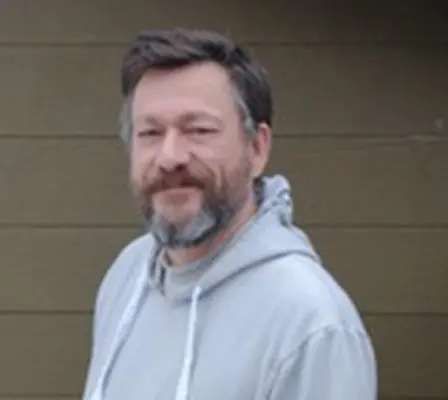Rob Thomas (District 34 York Region)
“Building our own cottage had always been one of those ‘Wouldn’t it be nice?’ things. Then, in 2020, all the fear and uncertainty of COVID hit. My wife, Anna, and I decided it was now or never.
“We started searching for lots where we could build our cottage. We put offers in, without success, but then Anna found a property online. I went up to look, and we put in an offer the same day. We probably overpaid — everyone overbid at that time — but it’s a big, very private property on a gorgeous, quiet lake near Haliburton. And it’s only about a two-hour drive from home.
“At the kitchen table, Anna and I began discussing what a cottage should look like and roughing out a layout.
“I pictured a small one-storey, while Anna wanted a bigger place with a loft. We threw that back and forth and came up with a medium size with a loft.
“I had no real experience drawing formal plans, but in Ontario, owners can draw their own building plans, and I learned from YouTube. By March 2021, after we had made a number of changes, the building inspectors approved our plans.
“It’s much, much easier to draw ideas than it is to actually build them. We thought we could do all the work — we had the time, even if we didn’t have the skills. Our vision was naive, and it became apparent that we’d need some help, at least for pouring the foundation, installing the electrical and sheathing the roof.
“To expand our little path into a driveway for the concrete trucks, I had to cut some trees. It broke my heart, but that’s when the project began to feel real and when we learned our first lesson: Don’t clear trees in May. Anna and I supported future blackfly colonies for years to come — we had hundreds, maybe thousands of bites.
“Then one morning at six, we were woken in our tent by the sound of trucks coming down the drive. We weren’t expecting them that day, but cottage-country contractors are so busy in summer, they operate on their own time frame. A few hours later, the concrete was poured. It was all a little overwhelming because we knew then there was no turning back.

“It took us two more years to build the cottage. About 90 per cent is our work. Our standard operating procedure was to build something, realize it was wrong, take it all apart and build it again. Where my MO was ‘We need to redo this,’ Anna’s MO became ‘That’s good enough — I’m sure it’ll be OK.’ Most of the time, she managed to persuade me to keep moving forward and fuss over things much less.
“We learned, from building inspectors, how incredibly strict and precise the Ontario Building Code is. The inspectors knew we were rookies, of course, so they had a good look at what we did. And they were helpful.
“Beams, especially, challenged us. Installing the main 40-foot beam — four two-by-tens — to support floor joists might have taken a few hours for a contractor. It took us two days. We were proud of ourselves, but then we stood back to look at the finished beam. It had a banana curve like a Bobby Hull hockey stick. So as usual, we took it apart and redid it.
“I would often take chances and circumvent the safe method. Anna was always on me, reminding me to do it right — especially things involving height, ladders, dangerous tools. I listened most of the time to the safety inspector. But I did manage to send a nail into my hand with the nail gun. I was reprimanded. (Anna’s a retired nurse, so that helped.)
“Challenges like that reminded me of back-country canoe trips Anna and I used to take — the toughest trips, which make you wonder, ‘Why are we doing this?’ But at the end, all you remember is ‘Wow, we kept going — what a fantastic trip.’ So I knew we wouldn’t give up.
“This project reinforced for me that Anna was strong and not shy of hard physical work. She would do any job and see it through no matter how difficult — I started calling her the ‘bulldog.’ At first, she was afraid of the big tools, especially the chop saw. But it wasn’t long before she was working them all like a pro. As time went on, she’d be cutting wood and passing it up to me on the scaffold, and I had learned not to comment on the ‘neatness’ of the cut, that it was ‘close enough’!
“As well as becoming pretty good on the construction site, Anna took care of the tent and outdoor kitchen. With just a Coleman stove and two coolers, we ate really well. Anna made sure meals were nutritious for the 12-hour, seven-day-a-week schedule that we tried to keep. She made the best campfires almost every evening, complete with fire-roasted potatoes.
“While we built, we lived very simply in a tent. We tented even into November. When the overnight low hits minus 11, you hate being there, but like a canoe trip, later you look back with satisfaction: ‘Yeah, we did it.’

“Anna was always positive. I would get really low some days when things weren’t going well, but she’d always have suggestions and see the good stuff.
“I decided to document the process, just for Anna and me. Then a friend suggested putting videos on YouTube so he could see what we did, too. And that’s when I started a YouTube channel called ‘River Rock Cabin.’ I had to learn how to shoot, edit and upload videos. Creating and uploading videos has been good for my old brain.
“At first, I expected a few friends might check out our channel. Who else would be interested in an old couple — I’m 73 now — stumbling and bumbling along? To our surprise, we started to get comments and followers from Australia, Korea, China, the UK and more. We’re up to about 110,000 views and 860 subscribers now. I believe people wonder if maybe they could also do something like this. Either that or they’re wondering what the heck these two old idiots are doing!
“Anna and I actually make a really good construction team. I was head of phys ed at Unionville High School and Anna was a nurse, so we had our own, separate careers. When we retired, we started to spend a lot more time together. Through three summers in a tent, building and rebuilding, I didn’t hear a single death threat. I did wonder occasionally if I should really be letting her hold the ladder for me! She was fantastic to work with.
“There were highs and lows, and great satisfaction in living outside, building together and watching the cottage slowly come together. When we’re there, Anna builds a campfire every night. Those are the best moments: sitting by the fire, roasting potatoes, rolling them in butter and reflecting on what we’ve accomplished that day.”










